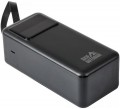USB С
USB type C is a popular type of USB connector characterized by its small size, reversible design, and fairly advanced (in theory) capabilities. If there are several connectors of this type, the first one is considered to be capable of delivering more power.
It is characterized by the rated power supplied by the power bank when a load is connected to the first or only
USB type C output and the current strength. The speed of the charging process directly depends on the power. It is traditionally calculated by multiplying the current by the voltage; However, the standard voltage for USB power is 5 V, so current is considered to be the main indicator of power.
The magnitude of the charging current directly determines the power supplied to the device being charged - and, accordingly, the maximum speed of the process (in practice, it may be lower if the device being charged has strict restrictions on the charge current). Power is also determined by the supply voltage (the number of watts is calculated by multiplying amperes by volts); While the standard USB output voltage is 5V, many fast charging technologies (see below) use higher voltages. Therefore, in the notes to this paragraph, the maximum power on the USB type C connector is also indicated.
As for specific values, the most popular option for USB type C outputs in modern power banks is
3 A. There are also other values - bo
...th smaller ( 2.4 A, 2.1 A and 2 A) and larger ones - but noticeably less frequently.USB A
A standard
USB A port is characterized by the rated power supplied by the power bank when a load is connected to the first or only USB A output and the current strength. If there are several connectors of this type, the first one is considered to be capable of delivering more power.
The speed of the charging process directly depends on this indicator. Power is traditionally calculated by multiplying current by voltage; However, the standard voltage for USB power is 5 V, so current is considered to be the main indicator of power.
The charging power and, accordingly, the speed of the process depend on the current strength. Nowadays, on USB ports, a current of
2 A or
2.1 A is considered basic and quite modest,
2.4 A and
2.5 A are average,
3 A and
more are noticeably above average, and certain fast charging technologies allow you to achieve values of
4 A. 4.5 A and
5 A. However, it is worth considering that to operate at high current, such an opportunity must be provided not only in the power bank, but also in the gadget being charged. So when purchasing a model, it doesn’t hurt to check whether the devices being charged suppo
...rt high charge currents.
It is also worth noting two nuances associated with the presence of multiple USB charging ports. Firstly, they may differ in the current they produce. This allows you to select the optimal connector for each device: for example, to quickly charge a tablet with a capacious battery, it is desirable to have a higher current, and a device with a low charging current can be connected to a “weaker” port, so as not to create unnecessary load on the battery and controller. The second caveat is that if all USB connectors are used simultaneously, the current supplied by each of these connectors may be lower than the maximum; in other words, not all power banks allow you to simultaneously use USB ports at the maximum possible power. You can understand whether such a possibility exists by looking at the charge power (see below); if the charge power is not indicated, you should refer to detailed documentation from the manufacturer.USB A (2nd)
Characteristics of the second USB A port. Read more in the paragraph above.
USB A (3rd)
Characteristics of the third USB A port. Read more in the paragraph above.
Power per USB-A (3rd)
Rated power output by the power bank when the load is connected to the third USB A port. For more information about this parameter, see "Power per USB A port (1st)".
USB-A current (3rd)
The rated power supplied by the power bank when a load is connected to the third USB port. For more information about this parameter, see “USB A current (1st)”.
USB A (4th)
Characteristics of the fourth USB A port. Read more in the paragraph above.
Power per USB-A (4th)
The rated power supplied by the power bank when a load is connected to the fourth USB A port. For more information about this parameter, see “Power per USB A (1st)”.
USB-A current (4th)
The rated power supplied by the power bank when a load is connected to the fourth USB port. For more information about this parameter, see “USB A current (1st)”.

